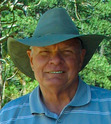Evan E. Filby's Blog: South Fork and More, page 116
July 16, 2013
Wild West History Association Roundup: Amazing Idaho History Event, and More
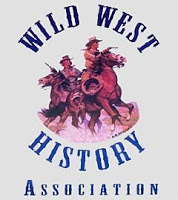 The 2013 Roundup (Annual Conference) of the Wild West History Association came to Idaho last week, continuing into Saturday. With talks at the Riverside Motel in Boise, and a tour of Idaho City, the event was a jewel for those interested in Western history. It was a special treat for someone interested in Idaho history. After the first day of presentations on Thursday, I “felt like I had died and gone to [historical] Heaven.”
The 2013 Roundup (Annual Conference) of the Wild West History Association came to Idaho last week, continuing into Saturday. With talks at the Riverside Motel in Boise, and a tour of Idaho City, the event was a jewel for those interested in Western history. It was a special treat for someone interested in Idaho history. After the first day of presentations on Thursday, I “felt like I had died and gone to [historical] Heaven.”Virtually every talk had great material, so I cannot possibly do jus...
Published on July 16, 2013 12:55
Idaho County Pioneer Association Holds First Organizational Meeting [otd 07/16]
The first organizational meeting of the Idaho County Pioneer Association was held on Saturday, July 16, 1887. Within a few weeks, the group adopted a constitution, elected officers, and recruited its first members.
 L. P. Brown with his wife and daughters, 1882.
L. P. Brown with his wife and daughters, 1882.
Historical Museum at St. Gertrude, Cottonwood, Idaho.
The Association selected Loyal P. Brown as its first President. In 1862, L. P. (as he was often called) decided to move his family from Oregon to the Florence, Idaho, mining district....
 L. P. Brown with his wife and daughters, 1882.
L. P. Brown with his wife and daughters, 1882.Historical Museum at St. Gertrude, Cottonwood, Idaho.
The Association selected Loyal P. Brown as its first President. In 1862, L. P. (as he was often called) decided to move his family from Oregon to the Florence, Idaho, mining district....
Published on July 16, 2013 00:08
July 15, 2013
Boise Brewer and Capitalist John Lemp Begins His Rise to Millionaire Status
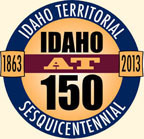 Around this date, July 15, 1863, prospector John Lemp decided that the area near the new Army post on the Boise River needed a little more time to develop. He had arrived at the spot a week earlier with a group from the gold fields of Colorado.
Around this date, July 15, 1863, prospector John Lemp decided that the area near the new Army post on the Boise River needed a little more time to develop. He had arrived at the spot a week earlier with a group from the gold fields of Colorado.Lemp emigrated to the United States from Germany in 1852, when he was just fourteen years old. Young John made his way to the Germany community in Louisville, Kentucky, where he found a position as a clerk. There, he learned to speak English, although h...
Published on July 15, 2013 00:30
Naturalist John Kirk Townsend Describes Fort Hall Area [otd 07/15]
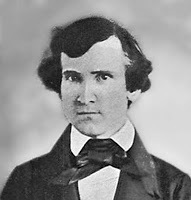 Naturalist Townsend.
Naturalist Townsend.Oregon Historical Society.On July 15, 1834, naturalist John Kirk Townsend described the site selected by Nathaniel Wyeth for the Fort Hall trading post [yesterday's blog].
Townsend wrote, "This is a fine large plain on the south side of the Portneuf, with an abundance of excellent grass and rich soil. The opposite side of the river is thickly covered with large timber of the cottonwood and willow, with a dense undergrowth of the same, intermixed with serviceberry and curran...
Published on July 15, 2013 00:01
July 14, 2013
Fur Trader Nathaniel Wyeth Selects Old Fort Hall Site [otd 07/14]
On July 14, 1834, Captain Nathaniel J. Wyeth wrote in his journal: "Went down the river about 3 miles and found a location for a fort."
This event occurred on Wyeth's second fur trading and trapping expedition west of the Rockies, discussed in my blogs for January 29 and December 20. After his customer at the rendezvous reneged on their contract, he took his unsold supplies on into Idaho.
Explaining this move to his long-suffering backers, Wyeth wrote, "I shall proceed about 150 miles west...
This event occurred on Wyeth's second fur trading and trapping expedition west of the Rockies, discussed in my blogs for January 29 and December 20. After his customer at the rendezvous reneged on their contract, he took his unsold supplies on into Idaho.
Explaining this move to his long-suffering backers, Wyeth wrote, "I shall proceed about 150 miles west...
Published on July 14, 2013 00:02
July 13, 2013
Stagecoach Robbery, and Murder, in Portneuf Canyon [otd 07/13]
On the afternoon of July 13, 1865, the stagecoach traveling south from the Montana gold fields towards Salt Lake City reached a point about ten miles southeast of today's Pocatello. They entered a stretch of Portneuf Canyon favored by bandits because heavy willow thickets crowded the road.
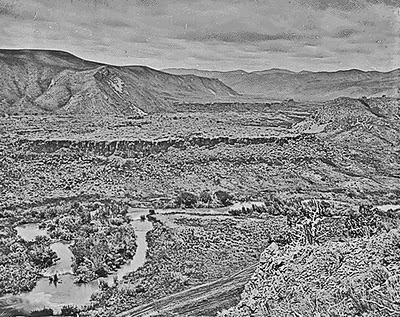 Portneuf Canyon, ca 1872. National Archives.Two of the seven passengers had reportedly boarded at Taylor's Crossing (today's Idaho Falls) while the others got on in Virginia City. Among them, the men carried...
Portneuf Canyon, ca 1872. National Archives.Two of the seven passengers had reportedly boarded at Taylor's Crossing (today's Idaho Falls) while the others got on in Virginia City. Among them, the men carried...
 Portneuf Canyon, ca 1872. National Archives.Two of the seven passengers had reportedly boarded at Taylor's Crossing (today's Idaho Falls) while the others got on in Virginia City. Among them, the men carried...
Portneuf Canyon, ca 1872. National Archives.Two of the seven passengers had reportedly boarded at Taylor's Crossing (today's Idaho Falls) while the others got on in Virginia City. Among them, the men carried...
Published on July 13, 2013 00:10
July 12, 2013
Strong Earthquake Rocks Central Idaho [otd 7/12]
In the early afternoon of July 12, 1944, a quick double-punch of earthquakes hit south-central Idaho. Later analysis placed the epicenter about forty miles west, and slightly south, of Challis, Idaho. Oddly enough, the quake was apparently not noticed there – at least the Challis Messenger carried no report.
The magnitude 6-7 quake severely impacted the Seafoam Ranger Station, located about ten miles north of the estimated epicenter. Witnesses there thought the station building might collapse...
The magnitude 6-7 quake severely impacted the Seafoam Ranger Station, located about ten miles north of the estimated epicenter. Witnesses there thought the station building might collapse...
Published on July 12, 2013 00:08
July 11, 2013
Boise Basin Mining Hampered by Lack of Water, but Prospectors Still Coming
 A correspondent for the San Francisco Evening Bulletin wrote a letter to the paper from Auburn, Oregon on July 11, 1863. The writer proposed to describe “the state of things in this region, and including an account, in brief, of the prospects of Boise.”
A correspondent for the San Francisco Evening Bulletin wrote a letter to the paper from Auburn, Oregon on July 11, 1863. The writer proposed to describe “the state of things in this region, and including an account, in brief, of the prospects of Boise.”The news was mixed. “There are some men there who are earning good wages working for others, and thousands are there idle, and unable to earn any wages at all.”
The problem was: “Boise is drying up, too, and in many localities the work of mining...
Published on July 11, 2013 00:30
Union and Non-Union Miners Killed in Coeur d'Alene Battle [otd 07/11]
On the morning of Monday, July 11, 1892, striking union miners and a crew at the Frisco Mine exchanged gunfire. The mine is located about four miles northeast of Wallace, Idaho. The crew consisted of replacement workers imported by the mining company and guards to protect them.
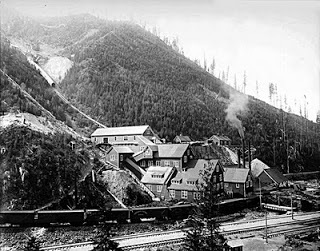 Frisco Mill, ca. 1890. University of Idaho Digital Archives.
Frisco Mill, ca. 1890. University of Idaho Digital Archives.
The conflict had started early in the year, when the mine owners reduced the wages paid to lower-skilled workers. Sure this was just the opening wedge for broa...
 Frisco Mill, ca. 1890. University of Idaho Digital Archives.
Frisco Mill, ca. 1890. University of Idaho Digital Archives.The conflict had started early in the year, when the mine owners reduced the wages paid to lower-skilled workers. Sure this was just the opening wedge for broa...
Published on July 11, 2013 00:09
July 10, 2013
First Structures Completed at Naval Ordnance Plant in Pocatello [otd 07/10]
On July 10, 1943 workers completed construction of the first usable structures for the Naval Ordnance Plant (NOP) about three miles north of Pocatello, Idaho. The Navy had authorized the Plant in the spring of the previous year. With more facilities completed later in the year, officials commissioned the NOP in early August, 1943.
Early in World War II, planners had to consider the possibility of attacks on the West Coast when they selected a site to refurbish big naval guns. Pocatello offered...
Early in World War II, planners had to consider the possibility of attacks on the West Coast when they selected a site to refurbish big naval guns. Pocatello offered...
Published on July 10, 2013 00:07
South Fork and More
As an author's vehicle, this blog will include my thoughts on the writing process, supplemental information about my books, and "status"updates on current projects.
My long-time blog -- the South Fork As an author's vehicle, this blog will include my thoughts on the writing process, supplemental information about my books, and "status"updates on current projects.
My long-time blog -- the South Fork Companion -- leans heavily toward Idaho history. In particular, I post an "On This Day" (OTD) item with an Idaho "spin" for every day of the year. I originally tried to have the system bring over the entire item, but the transfer does not handle the photo captions well. That's not good, because I generally include two images with each of my OTD posts. ...more
My long-time blog -- the South Fork As an author's vehicle, this blog will include my thoughts on the writing process, supplemental information about my books, and "status"updates on current projects.
My long-time blog -- the South Fork Companion -- leans heavily toward Idaho history. In particular, I post an "On This Day" (OTD) item with an Idaho "spin" for every day of the year. I originally tried to have the system bring over the entire item, but the transfer does not handle the photo captions well. That's not good, because I generally include two images with each of my OTD posts. ...more
- Evan E. Filby's profile
- 2 followers


